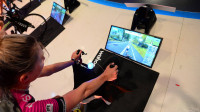![]() Follow britishcycling.org.uk on
Follow britishcycling.org.uk on ![]()
![]()
![]()
![]()
Bitesize Bikeability: Part 2: Left Turns
Bikeability is Cycling Proficiency for the 21st century, teaching the skills to ride confidently and safely on today's roads. In this series of articles we'll look at some of the key concepts introduced on a Bikeability course, and show you some of the resources used on our National Standard Instructor Training Courses. These articles are not intended to replace Bikeability training, but hopefully will give you a taste of what might be covered on a course.
Above: Stay where a car would be while turning.
How to Handle Left Turns
Turning left either into main roads or side roads is a relatively simple maneuver, but one which results in a surprising number of problems for cyclists. This article looks at how to take control of the road when turning left to avoid any conflict with other riders, vehicles or pedestrians. Whether you ride on busy city centre commuter routes, or train in the countryside on narrow lanes there are some simple tips here which apply to all scenarios.
Common Mistakes
1. Riding too close to the edge of the road can cause the following problems:
- The rider is not visible to following vehicles or pedestrians crossing the road
- The rider may be in the blind spot of vehicles turning left across their path- especially heavy good vehicles and buses
- The rider is encouraging vehicles to turn left alongside them, or turn right across their path, causing potential conflict if the road narrows or the rider has to swerve suddenly
2. Not signaling can cause the following problems:
- In urban areas pedestrians waiting to cross the road may walk into your path
- Vehicles will be unsure what the rider is doing and may attempt to squeeze past
- Other riders turning left may try to undertake at the corner
3. Riding up the inside (left side) of turning vehicles at junctions
It's tempting when riding in heavy traffic to squeeze through to the front of a queue on the left side of stopped or slow moving vehicles. Sometimes this maneuver is ok and a good way to move quickly in towns but consider the following potential problems:
- Vehicles which are currently stopped at traffic lights will start moving at some point- so you may need to move into the traffic flow
- Drivers may not able to see you on their left side, and if they could are probably looking ahead at the vehicle in front mostly
- Passengers may exit stopped vehicles suddenly, leaving an open door in your path
- Pedestrians crossing between standing traffic may not be looking for cyclists, and may not be visible to you around large vehicles
Top Tips
For all on road maneuvers the best guidance to follow is "be predictable, and be where a car would be". Drivers are looking for other vehicles and are used to dealing with other vehicles, so try to act like any other vehicle would.
It is important that you are confident and assertive, taking control of the situation. A confused or nervous driver is a dangerous driver, so take charge for them.
- Position yourself well away from the kerb before, during and after the turn
- Aim to ride in a position where a car would be
- Use a clear arm signal if there are other vehicles or pedestrians around you
- Avoid riding too close to the left side of vehicles in traffic
- Look ahead into the road you are joining for parked vehicles, slow traffic etc.
- Control your speed so you can change path or slow down quickly if needed- cover your brake levers at all times
- On narrow lanes look out for vehicles cutting the corner and crossing onto your side of the road
- Keep looking around at all times- on your right, left and ahead for anything changing
- Try to make eye contact with drivers or pedestrians nearby to check they have seen you
- Remember- when turning from a main road into a side road you have right of way so do not need to stop, but turning from a side road onto a main road you should Give Way at the junction

Above: Signal clearly to following vehicles, whilst controlling the lane.
More Information
The best way to improve your on road cycling skills is through completing a Bikeability course. These are available free to most young people through schools, and in certain areas training for adults is also free.
To find your local Bikeability scheme visit www.bikeability.org.uk
If you would like to train as a Cycle Training Instructor to deliver Bikeability courses more information on British Cycling's Instructor courses is available here.
If there is an on road maneuver you'd like us to look at in more detail in a future article please contact cycletraining@britishcycling.org.uk with your suggestions.
Previously...










